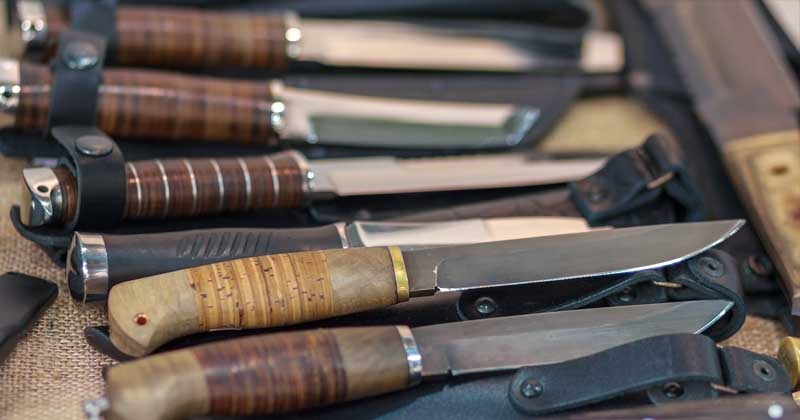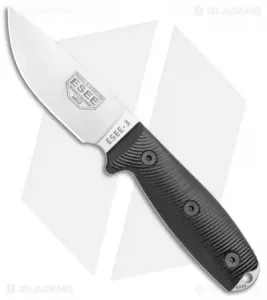11 Main Survival Blade Shapes (and their Pros and Cons)


[ad_1]
There are a lot of different types of survival knives, like neck knives, folding knives, combat knives…
After you’ve decided on what type of knife you need, the next step is to look at the blade shape.
The blade shape is what makes a knife suitable for certain tasks.
For example, you may want a blade shape that is better for:
- Splitting wood (batoning)
- Skinning game
- Slicing food
- Piercing
- Clearing brush
- Cutting netting
- Carving and whittling
What Is the Best Blade Shape for a Survival Knife?
The drop-point blade is considered the all-around best shape for survival knives.
The shape offers a good balance between strength, functionality, and ease of use. The runner-up is a clip blade knife shape. It has a bit more of a point so it is better for piercing and detailed work.
Survival Blade Knife Shapes
There are literally dozens of different knife blade shapes. These are the most common you will find on survival knives.
1. Drop point


The drop point blade shape is very common on survival knives (it’s also my personal favorite blade shape). The blade has a convex back which gradually slopes towards the point. You get a large cutting surface which is also very strong. It can handle tough tasks like batoning wood, but there is also a bit of a point for doing some precision work like carving.
Pros:
- Very strong
- Versatile
- Enough of a point for some detailed work
- Easy to handle
Cons:
- Not very good for piercing or self-defense
Example: ESEE-3 Fixed Blade Knife
2. Clip point
Clip point blades are also very common on survival knives. With this shape, the tip is clipped from the spine.
This means the cutting area (belly) is smaller than with the drop point blade, but you get a sharper point. The sharp point makes it better for stabbing, skinning and piercing tasks than a drop point.
However, a thin point isn’t going to be as strong. It’s easy to break the tip if you abuse the knife.
Pros:
- Versatile
- Strong enough for some tough tasks
- Pointy tip for precision work
Cons:
- Point not as strong as with drop point
Example: Ka-Bar Becker Combat Bowie Fixed Blade Knife
3. Trailing Point
Trailing point survival knives have a long, curving blade that comes to a fine point. I find them very attractive.
The curve gives the knife more belly, so it is great for slicing and skinning. They aren’t very strong and not suitable for stabbing. However, the fine point and long cutting surface make this type a favorite with hunters.
Pros:
- Large cutting surface
- Good for skinning and slicing
Cons:
- Weak tip and blade
- Not good for self defense
- Lacks versatility
Example: Benchmade Meatcrafter
4. Spear Point
Spear point blades have a convex curve on both sides and are usually sharp on both sides.
Because there is material on both sides of the point, the tip is quite strong. This shape is often used for throwing knives and daggers. The shape also means you can “drill” into wood with the tip.
Pros:
- Strong point
- Good for stabbing, hunting, and combat
- Nicely balanced for throwing
Cons:
- Small belly
- Not very good for slicing and cutting
- Lacks versatility
Example: CRKT Xolotl Liner Lock Knife
5. Needlepoint
A needlepoint survival knife is similar to a spear point blade. The difference is that needlepoint knives are narrower. The narrow point is sharp but weaker. There’s basically no cutting edge for it’s only really useful for stabbing.
Pros:
- Very sharp point
- Good for stabbing and self-defense
Cons:
- No belly for slicing
- Lacks versatility
- Weak tip
Example: Sgian Dubh Scottish Dirk Knife
6. Tanto
Tanto type survival knives are mostly popular because they look cool. They aren’t just gimmicks though. The shape creates two distinct cuttings edges. This is fairly versatile because you can cut but also get a point for precision work.
Pros:
- Great for piercing
- Fairly versatile
- Good for detailed work
Cons:
- Lacks strength for tough bushcraft tasks like batoning
- No belly so not suitable for slicing
- Hard to sharpen
Example: Hogue Sig Sauer EX-F01
7. Hawkbill
The hawkbill survival knife is the opposite of a trailing point. It is terrible for slicing but the hooked shape makes it great for cutting through tough materials like shrubs and rope.
You can put your fingers on the spine and press down to get a lot of force on this knife.
Pros:
- Cuts through tough materials
- Shape grabs brush, nets, fishing line, etc. well
- Shape lets you pierce down on materials
- Good for self-defense
Cons:
- Lacks versatility
- Terrible for slicing
- Higher learning curve
- Hard to sharpen
- Tip dulls quickly
Example: Spyderco Harpy Folding Utility Knife
8. Straight back
Also called a “standard” or “normal” survival knife, this shape has a flat back. That allows you to apply pressure to the blade. The shape is also pretty strong but not as versatile as a clip point. It’s more commonly found on cooking knives than survival knives.
Pros:
- Usually very thick and strong
- Good for heavy-duty tasks
- Large surface for chopping and slicing
- Good for combat and self-defense
Cons:
- Usually quite heavy
- Hard to control
Example: Condor Tool & Knife, SBK Knife
9. Sheepsfoot
The sheepsfoot (which was originally used for trimming sheep hooves) has a straight blade with a back that angles downwards.
The straight blade is great for cutting and you have a lot of control when holding it. There’s no point, so it is very strong. It’s also less likely that you will accidentally stab yourself. You’ll often see this blade shape on EMS knives.
Pros:
- Very easy to sharpen
- Easy to control
- Hard to accidentally stab oneself
Cons:
- Not for piercing
- No point – not for detailed work
- Not great for cutting and slicing
Example: Kubey Karaji KU180
10. Wharncliffe
The Wharncliffe blade shape is very similar to the sheepsfoot. The main difference is that the Wharncliffe (which was originally used by sailors) has more of an angle on the back, so you get a bit of a point on the blade.
The point and ease of control make it great for whittling.
Pros:
- Great for whittling
- Very easy to sharpen
- Easy to control
- Hard to accidentally stab oneself
Cons:
- Not for piercing or stabbing
- Not for heavy-duty tasks
- Tip wears down quickly
Example: Spyderco Salt 2 Knife
11. Kukri
Kukri survival knives are used in the army and are also common on machetes in some parts of the world.
The curved shape is great for bushwacking and very strong. It also has a decent tip on it so can be used for self-defense. It takes some practice to use but can be very versatile once you get the hang of it.
Pros:
- Very strong
- Great for chopping, bushwacking and building
- Good for self defense
Cons:
- High learning curve
- Not good for precision work
Example: Condor K-Tact Kukri Knife
What’s your favorite knife blade shape and why? Let us know in the comments section below.
[ad_2]
Source link
Recent Posts
Dear Diary, It’s Me, Jessica: Part 16
[ad_1] If you're new here, you may want to subscribe to my RSS feed. Thanks…
Google Faces Lawsuit After $5M in Crypto Stolen via Play Store App
[ad_1] A Florida woman, Maria Vaca, has sued Google in a California state court, alleging…
All About Water Purification: A Complete Tutorial
[ad_1] You may need to purify water to make it safe to drink. The process…
Protocol Village: Quai Releases Mainnet-Compatible Devnet, Crunch Lab Raises $3.5M
[ad_1] The latest in blockchain tech upgrades, funding announcements and deals. For the period of…
The Grim New Daily Life in Venezuela
[ad_1] If you're new here, you may want to subscribe to my RSS feed. Thanks…
World’s 3rd largest public pension fund buys $34M MicroStrategy shares
[ad_1] The third-largest public pension fund in the world has just bought nearly $34 million…
